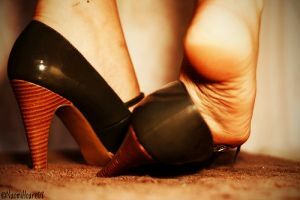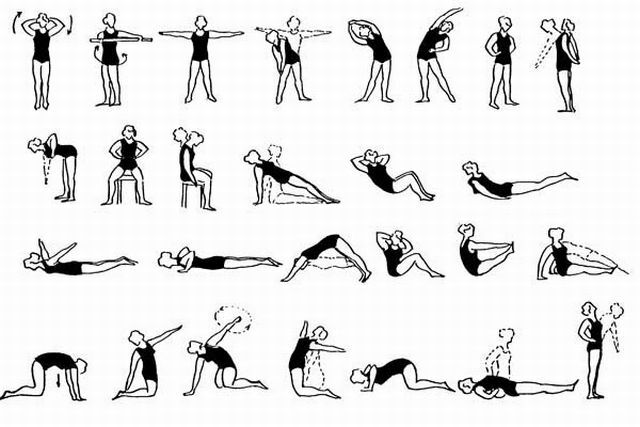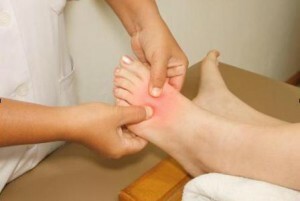 When the toe hurts, a person experiences discomfort, as there are difficulties during walking.
When the toe hurts, a person experiences discomfort, as there are difficulties during walking.
In addition, it can be a symptom of a serious illness.
Therefore, faced with such a nuisance, it is worthwhile to see a doctor to find out the cause of the pain as soon as possible, and then begin treatment.
Contents of the article
- Anatomical reference
- Pillow, nail, bone?
- In the area of risk joints and soft tissues of the fingers
- Edema, pain, discomfort is a gout
- Lesion of the fingers with arthritis
- Degenerative and degenerative destruction
- . .. Bursitis
- Inflammation of tendons on the feet
- Pain due to a finger injury
- Osteomyelitis is a dangerous and unpredictable disease
- Where else can danger come from?
- Diagnosis is an important step on the way to treatment
- How to get rid of the pain and discomfort
- For the prevention of
Anatomical reference
Foot and toes is one of the most important parts of the musculoskeletal system. When traveling, they withstand weight and move it, help maintain balance. Functionally, the foot of a healthy person is adapted for support.
Therefore, the fingers of the lower limbs are less mobile and much shorter than on the hands. In the skeleton of the foot I distinguish 3 sections - tarsus, metatarsus and phalanges of fingers. The toes, except for the large one, consist of 3 phalanges. I have only 2 phalanges.
Bones are articulated with each other using a cohesive apparatus of the reinforcing joint. Each bone is supported by certain muscles, and is braided by a network of blood vessels and nerves. Any damage to them can cause pain.
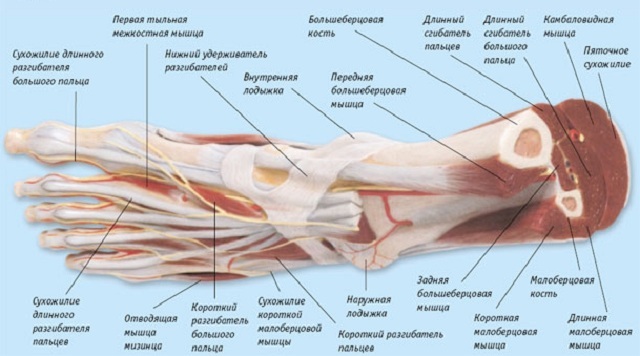
Pillow, nail, bones?
Fingernails can hurt in three different locations: the
- finger pad , most likely, hurts due to the coarsening of the skin on it, in this case special creams and pumice will help;
- nail can hurt because of uncomfortable shoes;
- but bones and joints usually hurt due to some pathology, which can only be diagnosed by a specialist.
In the area of risk, the joints and soft tissues of the fingers
The toes are aching very often and almost all people, but it happens for various reasons, usually the thumbs are affected, as they are injured most often.
Swelling, pain, discomfort is the gout
Gout is a disease that is based on an abnormality of purine metabolism. The pathological condition is characterized by 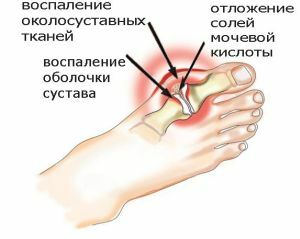 by increasing the concentration of uric acid in the vascular bed and depositing its salts in the tissues of the joints.
by increasing the concentration of uric acid in the vascular bed and depositing its salts in the tissues of the joints.
As a rule, an attack of the disease begins with severe pain in the joint of the big toe. With the progression of gout in the pathological process, all new joints and polyarthritis can be involved.
But most often the joints suffer from the disease, and the strongest pains are observed in the fingers. Usually, attacks of pathology occur at night.
The joint swells, the skin over it blushes, and becomes hot. An agonizing searing pain rises from the fingers up the leg. The inflammatory process can capture adjacent tissues, then the clinical picture resembles phlebitis or cellulite.
The average attack lasts a few days or even weeks. After passing the attack, the joint returns to normal.
Lesion of fingers with arthritis
Arthritis of the toes is characterized by symmetrical pain sensations, since it affects the same joints on both extremities. The pain syndrome is strongly pronounced and is observed both under loads and at rest.
Joints swell, deform, skin over them blushes, becomes hot. The amplitude of joint movement decreases, there is a crunch at loads.
With different types of arthritis, pain is observed in different fingers.
The thumb, for example, hurts with psoriatic and reactive arthritis.
Degenerative-dystrophic destruction of
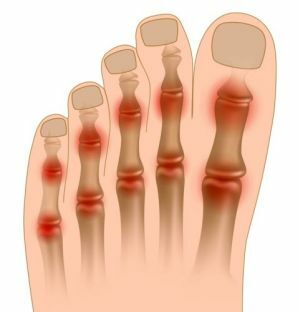 Another cause of arthrosis pain is degenerative-dystrophic joint pathology, in which destruction of cartilage is observed. In this case the pain is periodic.
Another cause of arthrosis pain is degenerative-dystrophic joint pathology, in which destruction of cartilage is observed. In this case the pain is periodic.
In this case, often the bones on the big toes hurt after walking, and passes at rest. But with the progression of the pathology, the pain syndrome becomes stronger, no longer leaves after rest, and sometimes even at night.
The disease is characterized by stiffness in the morning, painful seals on the edges of the joint space, a decrease in the amplitude of motion in the joint, a crunch during movements.
The thumb is deformed, a bone begins to protrude on it, which also deforms with time, and as a result all the fingers warp and grow in size. Due to the permanent traumirovaneye thumb in his joints bursitis progresses. ..
. .. Bursitis
The thumb swells, turns red, and becomes hot. The main feature of bursitis is the presence of mobile swelling in the area of the 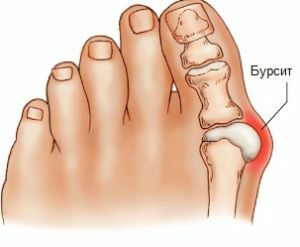 of the damaged joint. It is painful on palpation, and is clearly visible visually.
of the damaged joint. It is painful on palpation, and is clearly visible visually.
The disease can go to a chronic form. Then to the inflammatory process to join the deposition of calcium salts, as a result of which there will be a constant pain syndrome.
If bursitis was caused by a trauma to the big toe, then a secondary infection may be added to the inflammation. Develop purulent bursitis, and all signs become more pronounced, in addition, there is a general fever, nausea, weakness, etc.
Inflammation of tendons on the feet
Tendonitis - inflammation of the tendons is another cause of pain in the fingers of the lower limbs. When the process involves not only the tendons, but also the adjacent envelopes, tendosynovitis develops.
Bunches of the thumb suffer from this disease most often due to the fact that they are constantly injured. With inflammation of ligaments, pain sensations can be observed not only in the first finger, but in all the others.
The disease is characterized by crunches during movement, pain when walking, with palpation of tendons, calmness of pain at rest, skin hyperemia in the area of the affected joint, local temperature increase.
Pain due to a finger injury
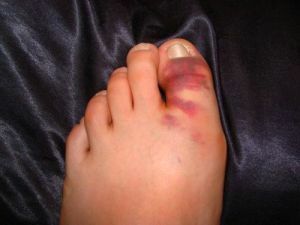 The finger phalanx is most often injured, as they are least protected from exogenous effects, and the bones themselves are small in diameter, and do not have sufficient strength.
The finger phalanx is most often injured, as they are least protected from exogenous effects, and the bones themselves are small in diameter, and do not have sufficient strength.
Phalanges of I and II fingers usually suffer from fractures, since they significantly protrude, in comparison with others.'
In the first hours after the fracture, there is a painful sensation in the area of the fracture upon palpation, swelling, pain, both during exercise and at rest, and bruises on the lateral and outer surfaces.
Tenderness and lameness during fracture persist for a long time. The main sign is that to reduce painful feelings, the victim, as a rule, tries to move the support to the heel.
Often in such cases, the finger hurts and near the nail.
Osteomyelitis is a dangerous and unpredictable disease
Osteomyelitis is a purulent necrotic process caused by a pathogenic microflora, affecting not only the skeleton, but also the bone marrow, as well as adjacent soft tissues.
Often this condition develops as a complication of various bone pathologies, such as an open fracture. The disease begins with a pyretic fever. Due to the increase in intoxication, the patient's well-being deteriorates sharply. 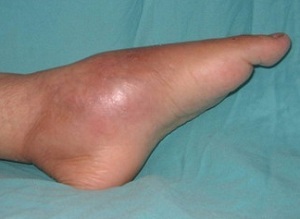
There is acute pain and swelling in the foot, chills, headache, vomiting opens, loss of consciousness and delirium, jaundice. During the first few days can go to the shin.
The patient can not move his fingers, contractures develop. Musculature and soft tissues of the feet and lower leg swell, the skin becomes purple and tense, usually a venous pattern is clearly visible on it.
If the pathology turns into a chronic form, the patient's well-being may improve slightly, the pains become aching and less pronounced. The overall temperature drops.
Usually, fistula is formed in the affected area, from which pus is released. These fistulas under the skin can be joined together and in the future open at a great distance from the pathological focus. As a result, the joints of the foot become fixed, and the fingers are bent.
Where else can danger come from?
Why still can hurt and swell your toes:
- Oni-cryptosis .Most often, the lesion occurs on the big toes, hurt the nails and is strong enough. Skin covers around
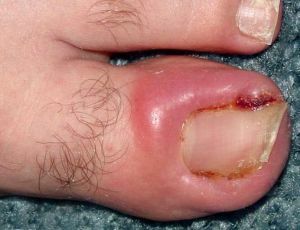 ingrown nail swell, blush, joins the infectious process.
ingrown nail swell, blush, joins the infectious process. - Valgus deformation is another cause of pain in the thumb. The anomaly is characterized by the curvature of its metatarsophalangeal joint and the remaining 4 fingers are also deformed. Pain syndrome increases with the wearing of tight shoes or high heels.
- Painful sensations can be due to an abnormal position of the foot - of clubfoot .Because of the pathological location of the foot when walking load on it are distributed unevenly, I finger is moved away from the outside and upwards, behind it the others are curved.
- Hammer-like deformity of the of the lower limbs, which appears due to thickening of the foot and excessive pressure on it. Fingers are pulled back and bend, as a result of the joints protrude forward and they quickly appear corns. Abnormal fingers constantly rub against the shoes, and irritation appears. With the progression of pathology, it is becoming increasingly painful for a person to walk.
- Corns .Usually they appear on the pads of the fingers, on the heels or on the lateral surfaces of the first finger. The pain increases with walking and pressure on the calluses, at rest, as a rule, unpleasant sensations are absent.
- Morton neuroma , or as it is called plantar fasciitis - is an inflammation of the ligamentous apparatus of the foot. Painful sensations are localized in this case in the base of the II, III and IV fingers, can extend to the shin, and are associated with a pinched nerve. Women are more common than men, as their spots are constantly traumatized when wearing heels. Pain syndrome increases with prolonged walking and wearing of heaviness.
- Diabetes mellitus , one of the signs of which is the pain in the fingers that occurs when walking. This changes
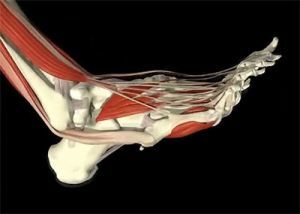 sensitivity of the lower extremities, there is burning in the feet, usually at night This is due to the violation of peripheral circulation and nerve damage.
sensitivity of the lower extremities, there is burning in the feet, usually at night This is due to the violation of peripheral circulation and nerve damage. - Vascular pathologies of , such as atherosclerosis of the arteries of the legs and endarteritis. In addition to pain during exercise and during supercooling, whitening of the fingers is observed, a feeling of coldness in the legs, regardless of the temperature of the environment.
When endarteritis arterial vessels become inflamed. One of the signs of the disease is "intermittent claudication", often there are cramps in the calf muscles. - Pain between the fingers can be caused by skin pathologies .Usually it is extensive mycosis of the feet, which are accompanied by itching and burning, deformity of the nail plate, pastosity of the fingertips, changes in the color of the skin.

The causes of edema and soreness in the toes - set
The ingrown nail is an unpleasant but solvable violation:
Diagnosis is an important step towards the treatment of
When a patient is treated with pain in the toes, the specialist conducts a visual examination of the limb, collects an anamnesis. Since most diseases have similar symptoms, the doctor prescribes additional tests:
- X-ray;
- ultrasound;

- determination of uric acid, rheumatoid factors;
- computed tomography;
- MRI;
- clinical analysis of urine( allows to determine arthritis in the last stages);
- general blood test( see ESR, leukocytes, sugar, hemoglobin);
- blood biochemistry.
How to get rid of the pain and discomfort of
If the pain in the fingers is due to injury, then you need to apply cold. Do not step on the injured limb. And as soon as possible, you should contact a specialist.
The main goal of therapy is to relieve pain and inflammation.
For this purpose, non-steroidal anti-inflammatory drugs are almost always prescribed. Recently, 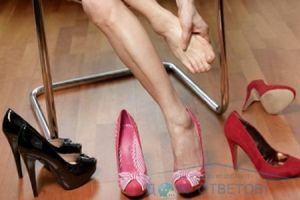 inhibitors of cyclooxygenase are more often prescribed, which have selective action and have fewer side effects, for example, Movalis. They are prescribed both in tablets and in injections.
inhibitors of cyclooxygenase are more often prescribed, which have selective action and have fewer side effects, for example, Movalis. They are prescribed both in tablets and in injections.
Place can be prescribed painkillers ointments and gels, for example, Naise, Orthofen.
When the pain is based on autoimmune diseases, hormonal drugs( dexamethasone) are prescribed that have analgesic effects and quickly stop inflammation.
Chondroprotectors, for example, Arthra, may be assigned to bone fractures.
With gout, prescribe drugs that lower the level of uric acid( Allopurinol) and diet.
In general, different methods of treatment are used depending on the provoking factor.
For prevention of
Prevention of pain and inflammation in the toes is as follows: 
- should avoid injuries;
- observe personal hygiene;
- wear comfortable shoes, do not walk long on high heels;
- correctly do the pedicure;
- avoid excessive loads;
- to lead an active lifestyle.
It is not necessary to leave the pain in your fingers without attention and to let everything slide, as the pathology can progress and lead to disability.


